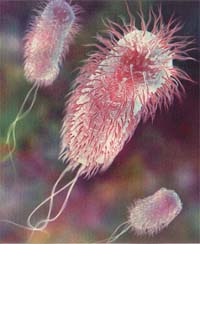 Addressing Foodborne Illness on the Farm - November 7, 2012 Jeff Schalau, Agent, Agriculture & Natural Resources University of Arizona Cooperative Extension, Yavapai County You may remember the 2011 Listeria outbreak that was linked to cantaloupe from a Colorado farm. This outbreak sickened 147 people in 28 states and caused 33 deaths. In this case, harvested melons were placed in trailers which carried them to a processing facility. Traces of the bacteria were found on equipment and the floor of the facility. It was suspected that the pathogen was inadvertently transported to the processing facility on a truck that had been used to haul culled cantaloupes to a nearby cattle ranch. Manure from the cattle ranch was the suspected source of the pathogen. The Listeria outbreak described above was one of our nation’s most lethal foodborne illness outbreaks. However, it may have been avoidable if the workers had followed suggested agricultural food safety protocols. On October 29 and 30, 2012, the Arizona Department of Agriculture (ADA) and the University of Arizona Cooperative Extension offered an eight-hour course in Cottonwood for growers, food distributors, and other interested parties called Good Handling Practices/Good Agricultural Practices (GHP/GAP). This training really increased my awareness of food safety risk factors and changed the way I will be teaching people about irrigation, soil preparation and post-harvest handling of produce. GHP/GAP certification is a voluntary program of the U.S. Department of Agriculture (USDA), but growers seeking new outlets for their produce should seriously consider certification. In short, GHP/GAP certification requires the grower to develop and implement a GHP/GAP Plan (a written document), keep accurate records of the plan implementation, and a yearly on-site audit of their operation to validate compliance (passing with a score of 80% or greater). This training is really targeted at growers that want to sell their produce to restaurants, schools, and wholesale/retail markets. Many of these produce buyers already require the seller to have liability insurance for the safety of their products and the GHP/GAP certification provides an official record of the grower’s compliance. In addition, the ADA has offered to reimburse 75% of the cost of the audit (up to $750). Some agricultural producers may feel this certification is just another government regulation hindering their ability to freely market their products. However, the incidences of foodborne illness continue and have far-reaching impacts on U.S. food security (economic, societal, agricultural, governmental, etc.). After attending the training, it is my opinion that Arizona has made GHP/GAP program understandable, attainable, and affordable. It will require participating growers to modify agricultural and post-harvest practices, keep records, and convene with auditors. It should also allow those growers to charge a premium for producing a safer product. In a broad sense, the GHP/GAP guidelines are aimed at prevention of foodborne illness risk factors related to water quality, animal manures, and animal intrusion. Irrigation water must be tested once per year from wells and municipal sources and three times per year where surface water is used for irrigation. Uncomposted manure can be used to amend soils, but it must be applied 14 days prior to planting and 120 days prior to harvest (this creates issues for short duration crops like spinach and radishes). Composted manure must meet organic growing standards which involve achieving pathogen-killing temperature ranges for specified time periods. Animal intrusion guidelines are related to monitoring fields for wildlife and domestic animal activity and flagging the location of any feces encountered. The marked locations would not be harvested within a specified radius (as specified in the GHP/GAP plan developed by the grower). In considering the animal intrusion guidelines, you might recall the E. coli 0157:H7 outbreak that occurred in spinach during September 2006. This outbreak was traced back to a coastal California ranch that leased land to a spinach grower. The suspected cause was feral pigs that carried the pathogenic E. coli into the spinach field through a breach in the fencing. This outbreak sickened 205 people in 26 states and ultimately killed 3 people. There is much more to meeting the GHP/GAP standards than I have indicated in this limited space, but I believe it is a common sense approach and provides lots of guidance that could be adopted by home gardeners. Meanwhile, on-farm food safety research continues. I will strive to report new findings as they are published. For more information on GHP/GAP, see the on-line version of this column. Thanks to my University of Arizona Cooperative Extension colleagues, Kurt Nolte and Karen Edwards and Stewart Jacobsen of the ADA for bring this training and information to northern Arizona growers! Follow the Backyard Gardener on Twitter – use the link on the BYG website. If you have other gardening questions, call the Master Gardener help line in the Camp Verde office at 928-554-8999 Ext. 3 or e-mail us at cottonwoodmg@yahoo.com and be sure to include your name, address and phone number. Find past Backyard Gardener columns or provide feedback at the Backyard Gardener web site: http://cals.arizona.edu/yavapai/anr/hort/byg/. Additional Resources Good Handling Practices and Good Agricultural Practices (GHP/GAP), Arizona Department of Agriculture, http://www.azda.gov/ACT/ghpgap.htm Multistate Outbreak of Listeriosis Linked to Whole Cantaloupes from Jensen Farms, Colorado, Center for Disease Control and Prevention, http://www.cdc.gov/listeria/outbreaks/cantaloupes-jensen-farms/082712/index.html Escherichia coli O157:H7 in Feral Swine near Spinach Fields and Cattle, Central California Coast, Center for Disease Control and Prevention, http://wwwnc.cdc.gov/eid/article/13/12/07-0763_article.htm |